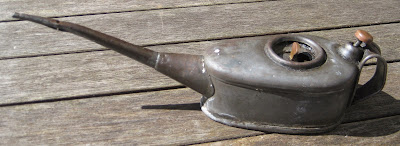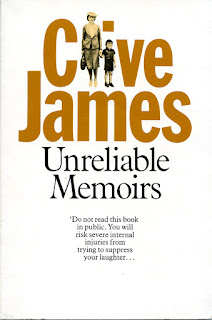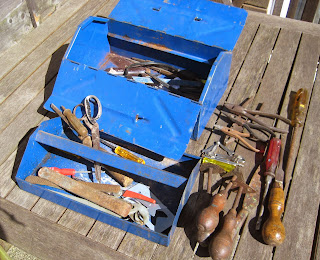Not long after my parents married in 1946, my maternal grandfather took my father to one side and, on account of the fact that his new son-in-law travelled in ladies underwear (so to speak) rather than having some more practical and manly occupation, told him, “Sither, th’d better ’ave these,” and gave him a set of tools. No doubt the items he passed on were surplus to his needs having acquired and inherited a considerable collection over his forty-five years.
Those tools, both my father’s and my grandfather’s, became very familiar
to me. My grandfather’s tools remained in his garden shed-cum-workshop, and after he had
died at what was even then an abysmally young age, I would sneak in to
‘play’ with his wood brace and drill bits, his awls and gimlets, his
planes, chisels, hammers and mallets, and other tools I couldn’t
identify, all logically arranged on purpose made hooks, racks and
shelves. Some may have been handed down from his own grandfather, who had w
orked with steam engines on barges in the 1870s. Both would have been as appalled by my lack of respect for them
as by my father’s mistreatment of the items he had been given.
My
grandfather’s immaculate collection of tools eventually went to one of
my uncles to be misused by his children, but my father’s neglected
assortment are among the jumble of tools I now have to sort out, having
over the years, just like my grandfather, bought, acquired and
inherited my own surplus.
Now rusty and unloved, so many of them bring back lost associations. There are the bicycle spanners and tyre levers I watched my father use to adjust saddles, remove wheels and mend punctures (see
Dad's Thursday Helper). There are thicker spanners and tyre levers from the toolkits of long-ago scrapped motor vehicles – his firm’s delivery vans – some marked ‘Bedford’, another labelled ‘Austin’, all in defunct British Standard Whitworth sizes.
There are broken files and sets of hard-handled pliers now so stiff it takes stronger hands than mine to pull them open. They carry the trademark of Elliott Lucas of Cannock which once made around half of all the pliers and pincers sold in the United Kingdom.
A group of wooden-handled, triangular scrapers reminds me of the time my father acquired a blowlamp and painstakingly scraped layers of old paint off the skirting board in the back room. Those old scissors are the ones my mother used for dead-heading the flowers in the garden.
There is a thick metal punch, its top battered down from when I used it to chip out a groove in the concrete under the door of the yellow shed I had taken over, to form a base for a ridge of cement to act as a barrier to the rainwater that pooled in, although it never worked. That was in 1965 – I know because I remember scoring the date in the top of the cement, it being my birthday.
Among the screwdrivers with bent or rounded blades is one with its wooden handle splintered down to half its original size through being bashed with a hammer when it served as a substitute cold chisel. Other screwdrivers were misused as makeshift levers and scrapers. One of them, the most damaged and least usable of them all, was left by a mechanic under the bonnet of one of my first cars after it had been in for repair. My father and I weren’t the only serial tool-abusers in town.
For the last thirty years or so, my father’s tools lived in an blue metal tool box. The bottom is now rusted through despite the amount of oil and grease covering everything inside, soaking into the wooden handles and attracting a filthy film of old paint, grease, grit and bits of insects. I had to wipe them clean before I could begin to sort them.
In addition there are my own tools, once new but now seemingly as old as my father’s. There are tools for painting and wallpapering, woodworking, home plumbing and electrical work, the legacy of years as a home owner. There are sets of AF and Metric spanners, feeler gauges, a spark-plug spanner, a brake spanner and other specialist implements from the days I serviced my own old bangers. There is a set of miniature silver tools that once came in a pouch designed to be carried in a car glove-box, which were always useless, consisting of an adjustable spanner that did not grip, a hinged set of spanners that were all the same size, and a handle with interchangeable screwdriver blades which somehow failed to fit any screw I ever wanted to turn.
And now – the event that forces me to sort them all out after all this time – I have acquired yet more tools, this time from my mother-in-law, some old and worn, others as good as new, little used and much better than mine.
I am afraid that most of the tools photographed, together with the rusty blue toolbox, are destined for the metal recycling skip, having checked ebay and found them to be effectively valueless.
Two particularly satisfying things I will keep.
“That’s my daddy’s ruler,” my wife said when we unearthed this thirty-six inch Rabone boxwood 1375 folding ruler in my mother-in-law’s garage. These beautiful devices were used widely before the invention of the ubiquitous retractable tape measure. Its four sections can be folded down to a single nine-inch length, or opened out to an arrow-straight yard long rule. There seem to be plenty still left around, probably because they are much too satisfying to throw away.

“That’s my daddy’s oil can,” is what I could have said when we found it in the cardboard box that came from my father’s garage nearly ten years ago. He used to fill it with used engine oil and like the spanners mentioned above, it may originally have been from an ancient motor vehicle tool kit. This type of oil can predated the present day tins with built-in plastic spouts. Unfortunately, because of damage, it would now only serve its original function with a sawn-off shortened spout, so I’ve cleaned it out with a hot solution of washing powder to keep as an object of interest. I recently saw a similar one in a Cotswolds antique shop for £100.
Good. That’s the tools sorted. Now for my accumulation of nails, screws, washers, brackets, hinges, piping, wiring, fuses, electric plugs, wall plugs, bath plugs, coat hooks, cup hooks, curtain hooks, door handles, fork ’andles and other bits and pieces. On second thoughts, it can wait a few more years. If I leave it long enough it will be someone else’s problem. Either that or open my own branch of Screwfix.


















